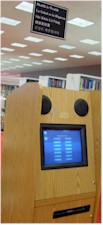News
The case for the bilingual kiosk
April 25, 2005
The case for the bilingual kiosk (El caso para el quiosco bilingüe)
The United States Census Bureau has made it official - Latinos have jumped ahead of African Americans as first in command of the American minority. In fact, the Latino population accounted for an estimated 39% of our inhabitant growth since 1980. With the Latino demographic now accounting for 13 percent of the nation's population, should bi-lingual capabilities in English and Spanish no longer be an option, but a norm, at the kiosk interface?
To address this paramount question KIOSK magazine contacted several kiosk software providers this month. "Our software already supports seventeen languages and we have implemented a tool where developers can select a language," said Heinz Horstmann with the kiosk software company PROVISIO LLC, creator of SiteKiosk. "There is a box integrated into the right side of the browser tool bar that is a drop-down box that allows kiosk users to pick their language of choice and the tool bar then automatically changes to their language," continued Horstmann.
Although California and Texas account for half of the U.S. Latino population, surprising numbers are coming up in metro areas around the country. What this means is that purchasing power for this market, an estimated purchasing power of $653 billion per year, continues to expand at an amazing rate in both geographic location and population. For example, the Latino growth rate was four times that of the national average equaling 9.8% from 2000 to 2002. And, in the 2000 census, it was determined that 28 million people now speak Spanish at home.
"We have multiple language support in GUI support for both the user and the developer administrative tools," said Michael Williams of the kiosk software provider Netstop. "The Latino market is huge and a failure to address that market can be dangerous," noted Williams. "There are stores and first generation Latino's who simply have not learned the language yet, but are a tangible and integral part of the population. We are building our software to have Spanish capabilities right out of the box."
Sources: National Geographic and National Geographic Maps, Brookings Institution Center on Urban and Metropolitan Policy, PEW Hispanic Center, and U.S. Census Bureau
Research
www.sitekiosk.com
www.netstoppro.com
 |
Houston Academy of Medicine-Texas Medical Center Library and the Houston Public Library
 |
The Texas Medical Center Library and the Houston Public Library have joined together in an effort to reach Houstons culturally-diverse community to provide free health information in their language. The Health is Wealth kiosk provides access to 37 health topics in five different languages, a total of 185 brochures of information in: Spanish, Vietnamese, Chinese, Korean, and English. Free printing of all brochures is also provided. Health topics include immunizations, nutrition, high blood pressure, domestic abuse, hepatitis, childrens health, and diabetes.
"Health awareness and information is important for all people regardless of nationality", said Barbara A.B. Gubbin, director of libraries, "and as an information center, the Library will now provide customers with easy access to free health information through the Health is Wealth kiosk in addition to other health information materials available at the Library, also free and in several languages."
Dr. Elizabeth K. Eaton, who provided historical background for this project, noted that in 1997 the HAM-TMC Library began a public health pilot outreach program to consumers with the Houston Public Library, a project supported by the National Library of Medicine. "Then as now, the primary purpose of these outreach projects is to design local programs for improving information access for health consumers," said Dr. Eaton. Emphasis is on providing information or access to health and medical information in a way meaningful to the target community. "With our new technology, the Health is Wealth kiosk, we continue this partnership."
Research
www.library.tmc.edu
www.houstonlibrary.org
Originally published in the Mar/Apr 2004 issue ofKioskmagazine.






